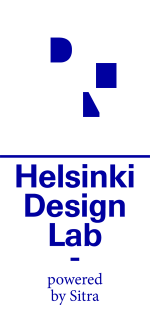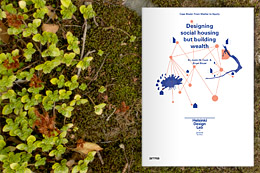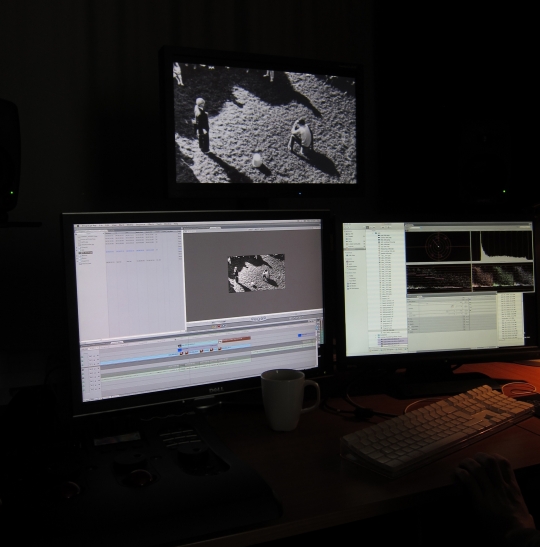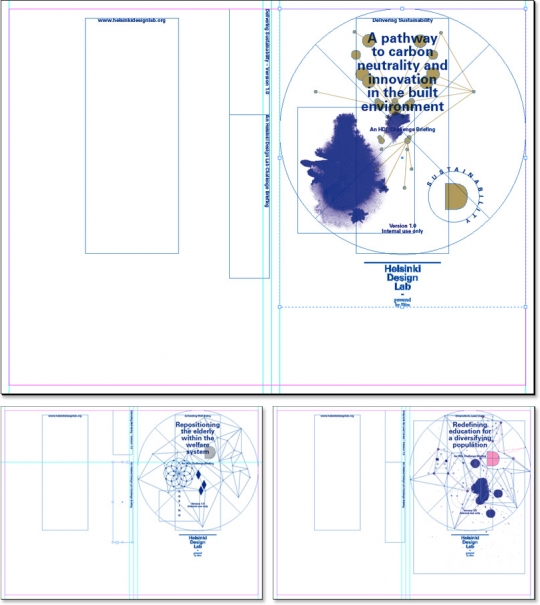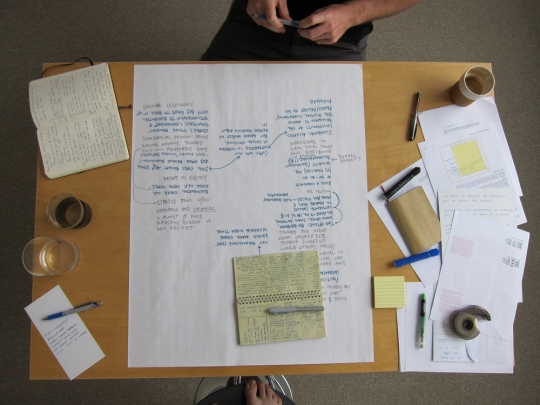Helsinki Design Lab helps government leaders see the "architecture of problems." We assist decision-makers to view challenges from a big-picture perspective, and provide guidance toward more complete solutions that consider all aspects of a problem. Our mission is to advance this way of working—we call it strategic design.
With just a few short days before the first studio guests arrive, we're in loppukiri ("final sprint") mode.
Seungho, Minna, Sanna, and Hanna have been handling all sorts of last minute items for the studio. We now have furniture, a full wall of whiteboard writing surface, internet access, a conference phone that looks like a space ship, and – most importantly – an account at the cafe next door.

Still rough around the edges, but getting there.
The instant we had furniture the studio assistants for our Education Studio were already powering full steam ahead. Rodrigo, Johanna, and Annikki have been covering a lot of ground as they research and map out the territory of education in Finland. Who are the key actors and what are the relationships between them? How are these institutions, organizations, and entities structured? Sunday is when the eight members of our studio arrive, so this work is not a minute too soon.
With May just a few days away, we ended the week with an all-hands meeting to review HDL Global 2010. The crowd grew from 10 to 12 as we welcomed Emil+Stephanie to present their work on the visual identity. The event plans are generally shaping up but there's still a lot to nail down, which is why Marco has been on the horn with Moscow, Washington, and many points in between.
Oh, and we launched the new website.
Feeling good about the accomplishments of 059, but already half way through week 060, it's time to turn up the Piazzolla and get back to work.
What do single use surgical instruments for the global market, social housing in Chile, and waste management in Bangalore have in common? When we set out to define what Helsinki Design Lab means by "strategic design" we knew that it would require illustrating our ideas with concrete examples, but none of us expected an initial group of case studies this diverse.
Unifying these projects is the ability of the teams behind them to work between different scales of their respective challenges, coordinating discrete decisions in a way that created opportunities to impact entire systems. We've started with three case studies but want to grow the library. Perhaps you have some ideas?
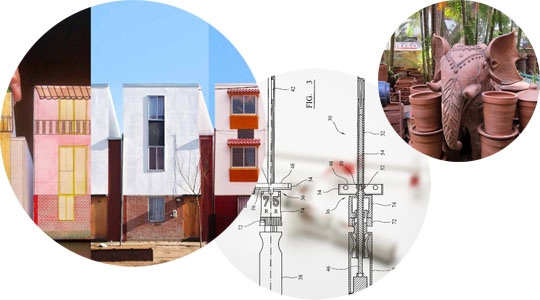
Can the specific architectural decisions of a house help lift its future residents out of poverty? Can something as basic as the material choice for a surgical tool improve patient outcomes? In the course of writing these case studies we found that the answers is yes! Talented designers are finding themselves increasingly able to tackle strategic questions and deliver measurable improvements for clients ranging from individual citizens, to global corporations, and government ministries.
Helsinki Design Lab wants to see more designers able to work at this level, more success stories, and more governmental clients benefitting from strategic design.
I'll let Marco follow up with a more complete introduction Helsinki Design Lab later this week, but for now "tervetuloa" and please enjoy our new site.
This site came together through the fantastic and speedy work of XOXCO and Rumors during the last six months, as well as early conversations with BERG on a fine September day, and a stellar visual identity courtesy of TwoPoints. Thanks everyone!
It was a big week for us, this week 058.
We moved in to our summer studio, printed a newspaper, and finished the new website. Go team!

Our location, soon to be furnished.
The studio space is located right in the heart of Helsinki, along the pedestrian patch of Kalevankatu. We've taken over from the excellent team at Nordkapp, who've moved on to a bigger office elsewhere in the city. To inaugurate the space we had a small party on Thursday with some of our local friends. With a bunch of people dropping by it seemed like a good opportunity to make sure they go home with some information about Helsinki Design Lab, so we designed and printed a tabloid newspaper in one week. Seungho took the lead on this and he did a great job. We'll have to figure out a way to make these papers available if you want a copy.

The first newsprint publication of HDL.
And the last big item is that we finally completed our new site. Once the eyes have been dotted and the tees crossed we will launch it, which means that the next time you read a weeknote like this it will be via our new online home.
But the biggest thing on our minds this weekend is what will happen with Eyjafjallajökull. If the skies don't clear up soon we're going to have to figure out a plan B for the HDL Studios, so this week ends with cautious optimism.
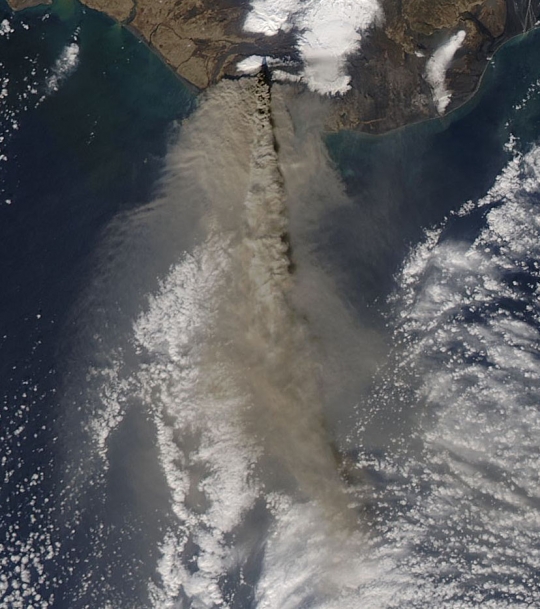
Courtesy of NASA Goddard's Flickr stream
Announcing a new approach to space exploration yesterday, President Obama shifted the focus from getting somewhere to building capability.
“Step by step, we will push the boundaries not only of where we can go but what we can do... In short, 50 years after the creation of NASA, our goal is no longer just a destination to reach. Our goal is the capacity for people to work and learn, operate and live safely beyond the Earth for extended periods of time.”
-President Obama in the New York Times
The Apollo project of the 1960s mobilized a massive amount of money, people, and effort to put a man on the moon. In the eight years between President Kennedy's announcement that the US would shoot for the moon and Neil Armstrong's first steps on lunar soil, NASA answered questions no one had ever asked before.
To be simplistic, there's no such thing as a single challenge. Challenges come in bundles. The difficulty is that it's very hard to predict in advance the nature of the bundle and to define the boundaries of the challenge. One may aspire to go to the moon but would they expect, from the outset, to research food enrichment as a step to getting there?
The sheer size of the Apollo project's ambition required the people involved to invent solutions to seemingly unrelated problems. The results of this are important to our everyday lives in ways that most people (including me) don't acknowledge, probably don't even know about. From enriched baby food to computer controlled fabrication (CNC), the secondary benefits of the space program are many, even if their pace has slowed.
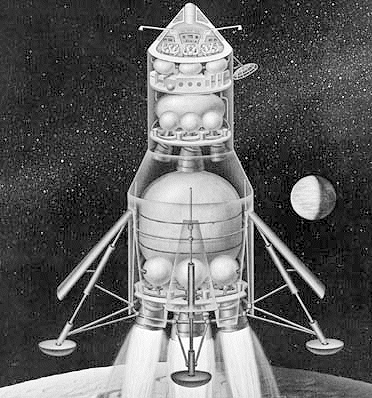
Source: Wikipedia
NASA's leadership of the space effort was a success in the 20th century when the target was difficult yet clear defined. One could argue that the success of the moon mission was derived from an institutional ability to pursue the right answer.
Nowadays we increasingly encounter problems that are ill-defined (or fuzzy or wicked, take your pick) and the question, as such, might not even exist yet. Today success still relies on choosing the right answer, as it always will, but we also have to ask the right questions.
This requires a shift of focus from building institutional capability towards building a culture of capability. Setting a new target, like Mars, may be dramatic, but it's not responsive to the ways that our context has changed in the past 40 years. We know the headlines (climate change, health care, etc) but the actual boundaries of these challenges need to be continually developed. To do this we need a culture that understands problems and solutions as moving targets, constantly in development together. HDL sees strategic design as one of the steps towards building this culture.
Neil Armstrong tacitly acknowledged the diminishing returns of a business-as-usual space program by noting that, "[going to Mars] will be expensive [and] it will take a lot of energy and a complex spacecraft. But I suspect that even though the various questions are difficult and many, they are not as difficult and many as those we faced when we started the Apollo (space program) in 1961." In other words, we know the boundaries of that problem pretty well and the development of new knowledge will be now incremental rather than stepwise.
The sheer complexity of working in space makes it a crucible of innovation, but unless we're asking the right questions and setting the right targets–unless we continue to define the boundaries of the challenge–the returns will continue to diminish.
For Mr. Kennedy it was enough to go to the moon because "it is there" and those were heady days. To deliver on Mr. Obama's intentions of an expanded capability to work and live in space we'll have to first figure out what it is we want to do. That sounds like a mighty design brief to me.
Three weeks from today, the first batch of HDL studio members will walk into the studio space and begin an intense week of work. Good thing we're picking up the keys tomorrow and can begin the build out!
We've been so focused on getting the studios squared away that it's hard to stop thinking about the week ahead. But last week some important things happened, so let's try to remember them.
The big item is that we welcomed another six new people to the team. Each of the three studio will have two Aalto University students supporting their work. Marco, Annikki, and I spent Friday morning introducing the new team members to HDL and strategic design. We're very excited to have them–and it's pretty amazing how quickly this team is growing. The studio assistants will be working with us through June.
Justin and I continued to shape up the case studies and website content while XOXCO made a final round of bug fixes. The new site is so very close to being done that I can barely stand it.
Tuesday was dedicated to video editing. Like our website, the brief interviews about HDL 1968 have been one of the items that we've been slowly chipping away at for a long time and they're finally getting close to done. Antti made some magic happen in Final Cut Pro. It will be great to have those videos online eventually.
We continued conversations with Emil+Stephanie who are providing design services for HDL Global 2010. It was a good meeting and we have some exciting plans in the works for the visual character of the event.
Seungho dedicated week 57 to designing a tabloid newspaper that explains HDL. We've been getting so many questions about what we do that it seems useful to have some kind of packaged information. That goes to press on Monday.
And thus week 57 comes to a close. It was busy, but with the first studio looming and many things on the docket, week 58 promises to be even more intense!
Sitting next to me on the desk is a stack of three slim volumes, each containing about 50 pages of research and argument. These books are called challenge briefings and they're the first step in organizing a strategic design studio.
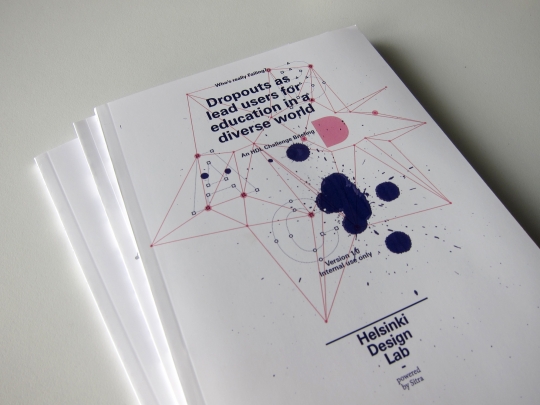
The first batch of Challenge Briefings are back from the printer! This is also a sneak peak into the new look of HDL. More when the new site launches.
A what?
A strategic design studio! HDL is hosting three studios this summer, each one looking at a systemic problem here in Finland. Since our new website is still forthcoming, here's a little peak into what the HDL Studios are all about.
The first studio will look at the broad theme of education with a specific focus on the "lost boys" of Finland, dropouts who disappear from the system completely. Our second studio is an extension of the intellectual capital devleoped by the Low2No competition and will concentrate on a national sustainability strategy with a focus on carbon neutrality in the built environment. Finally, the third studio is focusing on the challenges of an ageing society and how this impacts welfare and the welfare system.
For each of these studios we've built a small, top-notch team of eight experts with demonstrated leadership in their respective fields and a commitment to open and collaborative work. These teams will come together to spend a week with us in Helsinki and charrette on the topic. They are free to choose an appropriate medium, but each studio has been asked to develop a roadmap to strategic improvement and identify a "top ten" list of possible interventions. Given the understanding of the problem that will be collectively developing, what can be done to deliver significant improvement?
But back to those Briefings. They're following on the competition brief developed for Low2No and will be familiar to anyone who has seen a design brief before – only they're focusing on the opportunities for the redesign of systems rather than objects. Once we've seen how the studios make use of them we will revise the briefing documents and make them available on this website. This should happen later in the summer, so please bear with us.
With this one small but significant part of the puzzle completed, I'd like to thank Adriel Mesznik and Ezra block who took the lead on developing content for the Ageing and Education briefings respectively. Thanks, guys!
This was week 56: a short and blurry week. Three publications done and printed, one publication ramping up, a website that's almost done, and lots of other little bits keeping us busy.
The Ambiguous Middle Phase of the project – where we work all day, every day and seemingly have little to show for it – is still going strong. This was another week of familiar logistics and confirmations with a few highlights:
Leif Sonkin and Kimmo Rönkä, two of the authors of a Sitra report entitled Seniori 2000 looking at ageing society, dropped by for a meeting. They are enthusiastically revisiting the material and will be checking in with the municipalities involved to see what has come of their visions for the year 2000, now that we're ten years on. This will feed into our ageing studio.
The Challenge Briefings (one for each of our three studios) are 100% complete and press ready. Those files will be waiting in the press' inbox Monday morning. We're treating these as versioned documents so this will be version 1.0. That version number should tick up after the studio as our thinking develops, and hopefully many times after as well.
Marco was on the phone with Palo Alto and New York, as well as a few places around Europe. Interesting things developing for both HDL and Low2No but my lips are sealed for the moment.
We ended the week with an all-hands away day meeting to review the full compliment of plans for HDL studios and HDL Global. With the first studio beginning in just over a month, things are starting to feel more discrete. Sure, there's still a lot to do, but the work is less and less abstract. The to-do list is growing longer but the individual items are easier to check off, which is probably indicative of some equilibrium of work Law Of The Universe.
Finally, we would like to welcome Annikki to the team! She is going to be helping us with the HDL Studios by coordinating the teams of student research assistants who will be supporting each studio. In the coming weeks we'll post more about what a studio looks like and Annikki will have a better chance to introduce herself then.
Looking to the week ahead – um, tomorrow – we have a bit of a sprint before Easter holidays shut down Finland for a long weekend. Back to it!
This week felt a bit like a curling match: hastily tidying up a clean trajectory in advance of a moving object.
It involved some conversations with the in-house technology people who are now working on ICT for September, some preparations to bring on six Aalto University interns, confirming more guests for September, steadily taking care of logistics for the summer studios, and ongoing work on the Briefing documents.
Those Briefings are more work than we had expected, so they're eating into other projects (like the website). But it's worth it because the Challenge Briefings are the basis for the summer studios – they have to be great. We're supposed to send them to press in the upcoming week. That's a little scary.
Work on the case studies continued with calls to Leeds and London about knee caps and social housing, respectively.
Kari stopped by to fill us in on the plans for Helsinki Design Week. It's nice to have visitors, but I always feel a little guilty making them come down to Ruoholahti.
Which is why the big news of the week is that we finally confirmed the location of our summer studio space. It's a great spot right in the middle of Helsinki. I'm looking forward to seeing what Seungho whips up when he gets a chance to kit out the raw space as a hospitable studio environment for twelve people. We're going to look into having some open visitors' hours so that you can drop by and check out HDL too. Details on this when they develop.
We're definitely still in Ambiguous Middle Phase, but getting the hang of it now. If the next couple weeks go well, we should leave AMP behind and move to something that feels less like preparing and more like executing.
Here we are, currently closing out week two of a three-week intensive writing storm. Justin and I spent last week filling sheets of paper with what we call "fleshy skeletons," essentially long outlines that dip into narrative prose when inspiration strikes. This week he and I have shunted off to our own corners to put some meat on those skeletons. We're a bit behind schedule, but the week ahead will be a good one as the cases come into focus. Once we've drafted the bits we each committed to the files will go onto Google Docs and that's when the authorship-bending, polyvocal, swarm editing begins. Between writing stints we've had calls with the various parties being profiled in the cases as well as a good bit of research to fill in some of the gaps.
Marco has been steadily knocking things off the to-do list. Mostly in the section having to do with logistics and participants. We added two more confirmations to the Ageing studio, which is now almost full, as well as continued lining up speakers for all three studios. Jaana dropped by at the very end of the day on Friday with some special all-white, embossed Sitra stationery that none of us had ever seen before. Apparently it's reserved for diplomatic communiques.
I spent Friday interviewing Aalto students for the role of studio assistant. We're going to be brining on about three people to help with each of the studios, so that's a total of somewhere in the neighborhood of nine people to bring up to speed. Not to mention nine more seats that will be needed. Our new location in the Sitra building is bigger, but not that big.
Thus the studio. The biggest news is no news at all: we're still trying to confirm the HDL studio space. A couple very exciting options and we're very close, but the whole HDL team is quite ready to sign a lease and put this arduous task behind us. Who would have thought the real estate market in Helsinki to be so convoluted?
Week 053 feels like an extension of 052, one of the longest weeks of the project yet.
One year of HDL development! That went fast: two world tours, countless visits to friends on 5 continents, 3 studio briefings and some heavy logistical lifting. Where we are now (with 6 months to go) is a testament to the hard work of our team and the personal and institutional investment of our partners. Thank you!
But we are just getting started. Our work will become more visible in the coming weeks as we build a greater web presence, publish case studies and host our studios. To this end, Sitra’s Boston office was in full-scale knowledge creation mode this week. With great sadness, Bryan left Helsinki’s epic winter and flew to Boston to join me for the first week of a three week case writing push.
Why dump all that carbon just to write a couple dozen pages?* The short answer is that we needed to build a "bubble." The bubble is a magical space of extreme efficiency, supreme cognition and canny recollection. Once in the bubble, the complex work of creating documents that have real, lasting value is a little easier. With notebooks and the standard array of corporate innovation tools in hand—and the supportive environment of the bubble—we revisited our first three cases to try and better understand what happened in the projects, where design was instrumental, and why they reflect strategic design.
The breadth of the case study project is exciting: from positioning cities as strategic reserves and short cuts to equity, to design as a targeted risk mitigation tool in healthcare environments, to revaluing waste as a resource in a way that can realign the interests of citizens and their government, consumption habits and the environment. Each case provides evidence of how work at a discrete scale can have impact at much larger scales. When the bigger, often highly conflicted fields of play are understood not only as being inextricable from the discrete focus of a project, but also that they themselves are open to adaptive intervention by a skilled design team and supportive client, then the work of strategic design is being done.
The HDL and Low2No projects have necessitated new ways of working for our team. The cases are no exception. Our particular challenge this week was to rebuild the story of the projects both in terms of their chronology, and also the scales at which they operated. In some cases, the scalar question was obvious to those involved in the project, in others, large scale impacts became apparent to us as external, neutral observers. For instance, the redesign of a medical device had a clear impact on surgical pathway efficiency, and thus the hospital’s orthopedic business model (each surgeon could do roughly 3 more knee replacements per week). What was less clear, but equally important is the potential for a more accurate and easier to use medical device to change the way a hospital manages risk.
To help discover new perspectives such as this, Bryan and I "invented" an organized brain dump methodology that attempted to capture key elements of the case according to the 3 main structural components of each case study.
In the coming week, Bryan and I will return to Helsinki for more time in the bubble. We will add depth and formality to our case outlines and prepare them for publishing this month. Meanwhile, the rest of the team is hard at work as our studios and the September event draw near.
*We do buy carbon offsets for our airline travel…
